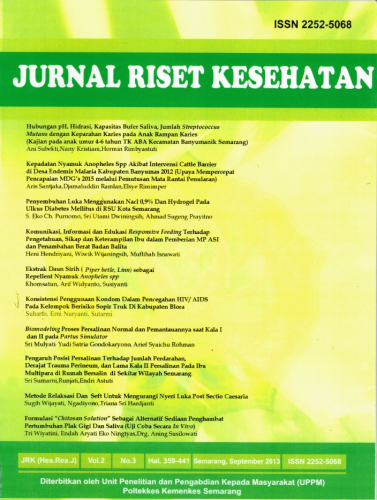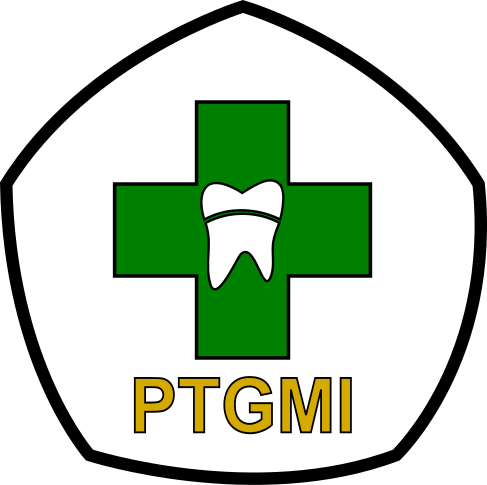DIFFERENCE OF THE IMAGE INFORMATION AXIAL PELVIC MRI USING DIFFUSION WEIGHTED IMAGE SEQUENCE WITH THE VARIATION OF B VALUE IN CERVICAL CANCER
Abstract
Cervical cancer is the second most common type of cancer worldwide, it is reaching 15% of all kind of cancer in women. There are several ways to diagnose cervical cancer, one of them is an MRI. One of the MRI sequences which can perform the pathology of cervical cancer is Diffusion-Weighted Image. The aim of this research is to find out the anatomical differences between axial slice image of Pelvic MRI which is using DWI sequence with the variation of b value in the case of cervical cancer, and also to reveal the optimal b value to obtain the image of Pelvic MRI which is using DWI sequence in the case of cervical cancer. The method of this research is experimental with the comparison of static groups. Data is 30 images of axial DWI Pelvic MRI from 10 patients in the case of cervical cancer with 3 different variations of b value, which are 600 s/mm2, 800 s/mm2, and 1000 s/mm2. Assessment of information image data done by the radiologist. Data analysis by Friedman and Wilcoxon Test. The result showed that there are differences of image information between axial Pelvic MRI which is using the DWI sequence with the variation of b value in the case of cervical cancer with a significant p-value less than 0.001. Differences in image information occur in the tumor, expansion of tumor, parametrium until the pelvic wall and lymph. The optimal use of b value for axial Pelvic MRI with DWI sequence in the case of cervical cancer is 600 s/mm2.
Keywords
Full Text:
PDFReferences
Blink. Evert, J., 2004, Basic MRI Physics, www.mri-physics.net
Bammer R. Basic principles of diffusion-weighted imaging. Eur J Radiol 2003;45:169–184.
Bruegel M, Gaa J, Waldt S, et al. Diagnosis of hepatic metastasis: comparison of respiration-triggered diffusion-weighted echoplanar MRI and five T2-weighted turbo spin-echo sequences. Am J Roentgenol 2008;191:1421–1429.
Diananda, 2009, Mengenal Seluk - Beluk Kanker, Yogjakarta: Katahati
Dietrich Olaf et al. Magnetic resonance noise measurements and signal‐quantization effects at very low noise levels. Magn Reson Med 2008;60:1477–1487.
Hagmann P, Jonasson L, Maeder P, Thiran JP, Wedeen VJ, Meuli R. Understanding diffusion MR imaging techniques: from scalar diffusion-weighted imaging to diffusion tensor imaging and beyond. Radiographics 2006;26(Suppl 1):205–223.
Hornak, J.P., 2011, The Basics of MRI Interactive Learning Software, Henietta: New York.
Kuperman, Vadim., 2000, Magnetic Resonance Imaging, Physical Principles And Application, United States Of America. Academic Press
Moeller, Torsten B. M. D., 2003, MRI Parameters and positioning, Am caritas krankehaus billingen/saar, New York
Mustari., 2006, Kanker leher Rahim, http://hgBKKBN/artikel/htm
Wijaya., 2010, Pembunuh Ganas Itu Bernama Kanker Serviks, Yogyakarta: Niaga Swadaya.
Westbrook, Catherine. Roth, Carolyn, Kaut. & Talbot, John., 2011. MRI in Pratice Fourth Edition, United Kingdom, Wiley - Blackwell
Worthington, Brian S., 2001, Magnetic Resonance Imaging, http://onlinelibrary.wiley.com
Yoshikawa T, Kawamitsu H, Mitchell DG, et al. ADC measurement of abdominal organs and lesions using parallel imaging technique. Am J Roentgenol 2006;187:1521–1530
Zafer Koc, MD,* and Gurcan Erbay, MD OptimalbValue in Diffusion-Weighted Imagingfor Differentiation of Abdominal Lesions, Journal Of Magnetic Resonance Imaging 40:559–566 (2014)
DOI: https://doi.org/10.31983/jrk.v8i2.5446
Article Metrics
Refbacks
- There are currently no refbacks.
Copyright (c) 2019 Jurnal Riset Kesehatan




















































